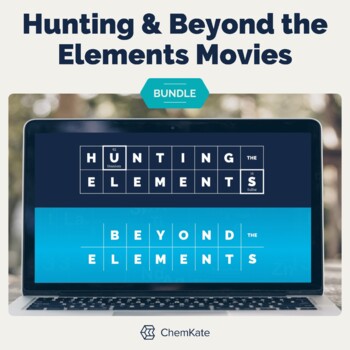Hunting and Beyond the Elements Series Movie Guides Digital Printable Worksheets
- Zip
- Google Apps™

Products in this Bundle (4)
Also included in
- Science movie guides for middle or high school science just became more amazing with these self-grading digital, editable, and printable question movie guides for you or subs. PBS science movies keep your students engaged, bring content to life, learn beyond the textbook, and provide teachable momenPrice $33.49Original Price $41.93Save $8.44
Description
Watching NOVA’s Hunting the Elements and Beyond the Elements Series specials as David Pogue explores basic chemistry, engineering, and silly humor just became more amazing with these self-grading digital, editable, and printable 44 -78 question movie guides! Keep your students engaged with PBS movie with animations and demos that can be broken into individual portions or shown as a whole. Even if a movie can't be shown in one class period, the Google form will keep students' answers for you. Great for middle through high school, regular or sub days. These movie/documentaries can be streamed for free on the PBS site: Hunting the Elements and Beyond the Elements, as well as commonly found at local libraries.
✦ This, along with other science movies are available in my time and costs-savings Science Movie Guides Bundle ✦
Each guide includes:
- 44 - 78 question self-grading and editable Google forms with times marked for each section
- PDFs of movie worksheets and answer keys
- Google slides of editable movie worksheet, which can be downloaded in various formats, such as Microsoft
Movies/Documentaries included:
- NOVA PBS Hunting the Elements (2 hr)
- NOVA PBS Beyond the Elements 1: Reactions (1 hr)
- NOVA PBS Beyond the Elements 2: Indestructible (1 hr)
- NOVA PBS Beyond the Elements 3: Life (1 hr)
Documentary Synopsis
Hunting the Elements:
- Where do nature's building blocks, called the elements, come from? They're the hidden ingredients of everything in our world, from the carbon in our bodies to the metals in our smartphones. To unlock their secrets, David Pogue, technology columnist and lively host of NOVA's popular "Making Stuff" series, spins viewers through the world of weird, extreme chemistry: the strongest acids, the deadliest poisons, the universe's most abundant elements, and the rarest of the rare—substances cooked up in atom smashers that flicker into existence for only fractions of a second.
Beyond the Elements:
- Picking up where he left off in NOVA’s popular special, Hunting the Elements, David Pogue sets out on a worldwide quest to find the key molecules and chemical reactions that have paved the way for human civilization, life, and even the universe as we know it. And along the way, he uncovers the simple principles that produce such a dizzying diversity of matter from elements on the periodic table. (Source: PBS.org)
You may also like:
- Main Group Periodic Table Battleship - a fun game of main group element patterns
- Chemistry I Digital Task Cards - a wide variety of self-grading Boom cards and interactive Google slides
- Classifying Matter Maze - Particle-diagram classification of matter in a self-correcting maze
Interested in more?
Mole and Stoichiometry Resources
● Be sure to follow my store to be alerted of new products: CLICK HERE
● Did you know that you can receive credit towards future TpT purchases by reviewing this product? Please help my store grow by leaving a review on the product page or through "My Purchases" under "My Account" at TpT. I enjoy making products to help you be successful in the classroom, so if you have any other questions or suggestions, please contact me KateCk@chemkate.com or in the "Ask a Question" tab above.





